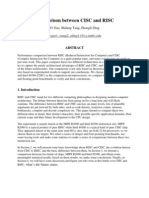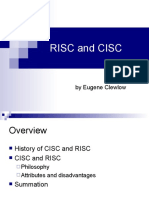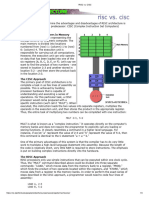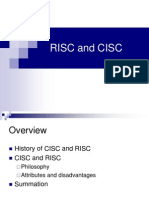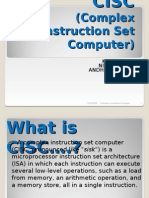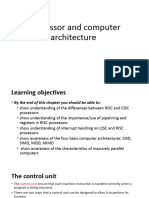RISC Vs CISC
RISC Vs CISC
Uploaded by
Alfred LunsinCopyright:
Available Formats
RISC Vs CISC
RISC Vs CISC
Uploaded by
Alfred LunsinOriginal Description:
Original Title
Copyright
Available Formats
Share this document
Did you find this document useful?
Is this content inappropriate?
Copyright:
Available Formats
RISC Vs CISC
RISC Vs CISC
Uploaded by
Alfred LunsinCopyright:
Available Formats
CPU PROCESSING METHODS-RISC vs CISC INTRODUCTION What is RISC?
RISC, or Reduced Instruction Set Computer. is a type of microprocessor architecture that utilizes a small, highly-optimized set of instructions, rather than a more specialized set of instructions often found in other types of architectures. History
The first RISC projects came from IBM, Stanford, and UC-Berkeley in the late 70s and early 80s. The IBM 801, Stanford MIPS, and Berkeley RISC 1 and 2 were all designed with a similar philosophy which has become known as RISC. Certain design features have been characteristic of most RISC processors: one cycle execution time: RISC processors have a CPI (clock per instruction) of one cycle. This is due to the optimization of each instruction on the CPU and a technique called PIPELINING. pipelining: a techique that allows for simultaneous execution of parts, or stages, of instructions to more efficiently process instructions; large number of registers: the RISC design philosophy generally incorporates a larger number of registers to prevent in large amounts of interactions with memory
The simplest way to examine the advantages and disadvantages of RISC architecture is by contrasting it with it's predecessor: CISC (Complex Instruction Set Computers) architecture. Multiplying Two Numbers in Memory On the right is a diagram representing the storage scheme for a generic computer. The main memory is divided into locations numbered from (row) 1: (column) 1 to (row) 6: (column) 4. The execution unit is responsible for carrying out all computations. However, the execution unit can only operate on data that has been loaded into one of the six registers (A, B, C, D, E, or F). Let's say we want to find the product of two numbers one stored in location 2:3 and another stored in location 5:2 - and then store the product back in the location 2:3. The CISC Approach The primary goal of CISC architecture is to complete a task in as few lines of assembly as possible. This is achieved by building processor hardware that is capable of understanding and executing a series of operations. For this
Page 1
particular task, a CISC processor would come prepared with a specific instruction (we'll call it "MULT"). When executed, this instruction loads the two values into separate registers, multiplies the operands in the execution unit, and then stores the product in the appropriate register. Thus, the entire task of multiplying two numbers can be completed with one instruction: MULT 2:3, 5:2 MULT is what is known as a "complex instruction." It operates directly on the computer's memory banks and does not require the programmer to explicitly call any loading or storing functions. It closely resembles a command in a higher level language. For instance, if we let "a" represent the value of 2:3 and "b" represent the value of 5:2, then this command is identical to the C statement "a = a * b." One of the primary advantages of this system is that the compiler has to do very little work to translate a high-level language statement into assembly. Because the length of the code is relatively short, very little RAM is required to store instructions. The emphasis is put on building complex instructions directly into the hardware. The RISC Approach RISC processors only use simple instructions that can be executed within one clock cycle. Thus, the "MULT" command described above could be divided into three separate commands: "LOAD," which moves data from the memory bank to a register, "PROD," which finds the product of two operands located within the registers, and "STORE," which moves data from a register to the memory banks. In order to perform the exact series of steps described in the CISC approach, a programmer would need to code four lines of assembly: LOAD A, 2:3 LOAD B, 5:2 PROD A, B STORE 2:3, A At first, this may seem like a much less efficient way of completing the operation. Because there are more lines of code, more RAM is needed to store the assembly level instructions. The compiler must also perform more work to convert a high-level language statement into code of this form. CISC Emphasis on hardware Includes multi-clock complex instructions RISC Emphasis on software Single-clock, reduced instruction only
Memory-to-memory: Register to register: "LOAD" and "STORE" "LOAD" and "STORE" incorporated in instructions are independent instructions Small code sizes, high cycles per second Low cycles per second, large code sizes
Transistors used for storing Spends more transistors complex instructions on memory registers However, the RISC strategy also brings some very important advantages. Because each instruction requires only one clock cycle to execute, the entire program will execute in
Page 2
approximately the same amount of time as the multi-cycle "MULT" command. These RISC "reduced instructions" require less transistors of hardware space than the complex instructions, leaving more room for general purpose registers. Because all of the instructions execute in a uniform amount of time (i.e. one clock), pipelining is possible. Separating the "LOAD" and "STORE" instructions actually reduces the amount of work that the computer must perform. After a CISC-style "MULT" command is executed, the processor automatically erases the registers. If one of the operands needs to be used for another computation, the processor must re-load the data from the memory bank into a register. In RISC, the operand will remain in the register until another value is loaded in its place. The Performance Equation The following equation is commonly used for expressing a computer's performance ability:
The CISC approach attempts to minimize the number of instructions per program, sacrificing the number of cycles per instruction. RISC does the opposite, reducing the cycles per instruction at the cost of the number of instructions per program. RISC Roadblocks Despite the advantages of RISC based processing, RISC chips took over a decade to gain a foothold in the commercial world. This was largely due to a lack of software support. Although Apple's Power Macintosh line featured RISC-based chips and Windows NT was RISC compatible, Windows 3.1 and Windows 95 were designed with CISC processors in mind. Many companies were unwilling to take a chance with the emerging RISC technology. Without commercial interest, processor developers were unable to manufacture RISC chips in large enough volumes to make their price competitive. Another major setback was the presence of Intel. Although their CISC chips were becoming increasingly unwieldy and difficult to develop, Intel had the resources to plow through development and produce powerful processors. Although RISC chips might surpass Intel's efforts in specific areas, the differences were not great enough to persuade buyers to change technologies. The Overall RISC Advantage Today, the Intel x86 is arguable the only chip which retains CISC architecture. This is primarily due to advancements in other areas of computer technology. The price of RAM has decreased dramatically. In 1977, 1MB of DRAM cost about $5,000. By 1994, the same amount of memory cost only $6 (when adjusted for inflation). Compiler technology
Page 3
become more sophisticated, so that the RISC use of RAM and emphasis on software has become ideal.
Definition
RISC (reduced instruction set computer)
E-mail Print A AA AAA LinkedIn Facebook Twitter Share This Reprints
RISC (reduced instruction set computer) is a microprocessor that is designed to perform a smaller number of types of computer instructions so that it can operate at a higher speed (perform more millions of instructions per second, or MIPS). Since each instruction type that a computer must perform requires additional transistors and circuitry, a larger list or set of computer instructions tends to make the microprocessor more complicated and slower in operation. John Cocke of IBM Research in Yorktown, New York, originated the RISC concept in 1974 by proving that about 20% of the instructions in a computer did 80% of the work. The first computer to benefit from
iSeries Resources
this discovery was IBM's PC/XT in 1980. Later, IBM's RISC System/6000, made use of the idea. The term itself (RISC) is credited to David Patterson, a teacher at the University of California in Berkeley. The concept was used in Sun Microsystems' SPARC microprocessors and led to the founding of what is now MIPS Technologies, part of Silicon Graphics. A number of current microchips now use the RISC concept. The RISC concept has led to a more thoughtful design of the microprocessor. Among design considerations are how well an instruction can be mapped to the clock speed of the microprocessor (ideally, an instruction can be performed in one clock cycle); how "simple" an architecture is required; and how much work can be done by the microchip itself without resorting to software help. Besides performance improvement, some advantages of RISC and related design improvements are:
Page 4
A new microprocessor can be developed and tested more quickly if one of its aims is to be less complicated. Operating system and application programmers who use the microprocessor's instructions will find it easier to develop code with a smaller instruction set. The simplicity of RISC allows more freedom to choose how to use the space on a microprocessor. Higher-level language compilers produce more efficient code than formerly because they have always tended to use the smaller set of instructions to be found in a RISC computer.
After the introduction of RISC, any "full-set" instruction computer was said to use complex instruction set computing (CISC).
The historical approach
Perhaps the most common approach to comparing RISC and CISC is to list the features of each and place them side-by-side for comparison, discussing how each feature aids or hinders performance. This approach is fine if youre comparing two contemporary and competing pieces of technology, like OSs, video cards, specific CPUs, etc., but it fails when applied to RISC and CISC. It fails because RISC and CISC are not so much technologies as they are design strategies--approaches to achieving a specific set of goals that were defined in relation to a particular set of problems. Or, to be a bit more abstract, we could also call them design philosophies, or ways of thinking about a set of problems and their solutions. Its important to see these two design strategies as having developed out of a particular set of technological conditions that existed at a specific point in time. Each was an approach to designing machines that designers felt made the most efficient use of the technological resources then available. In formulating and applying these strategies, researchers took into account the limitations of the days technologylimitations that dont necessarily exist today. Understanding what those limitations were and how computer architects worked within them is the key to understanding RISC and CISC. Thus, a true RISC vs. CISC comparison requires more than just feature lists, SPEC benchmarks and sloganeeringit requires a historical context. In order to understand the historical and technological context out of which RISC and CISC developed, it is first necessary to understand the state of the art in VLSI, storage/memory, and compilers in the late 70s and early 80s. These three technologies defined the technological environment in which researchers worked to build the fastest machines.
Page 5
Storage and memory
Its hard to underestimate the effects that the state of storage technology had on computer design in the 70s and 80s. In the 1970s, computers used magnetic core memory to store program code; core memory was not only expensive, it was agonizingly slow. After the introduction of RAM things got a bit better on the speed front, but this didnt address the cost part of the equation. To help you wrap your mind around the situation, consider the fact that in 1977, 1MB of DRAM cost about $5,000. By 1994, that price had dropped to under $6 (in 1977 dollars) [2]. In addition to the high price of RAM, secondary storage was expensive and slow, so paging large volumes of code into RAM from the secondary store impeded performance in a major way. The high cost of main memory and the slowness of secondary storage conspired to make code bloat a deadly serious issue. Good code was compact code; you needed to be able to fit all of it in a small amount of memory. Because RAM counted for a significant portion of the overall cost of a system, a reduction in code-size translated directly in to a reduction in the total system cost. (In the early 90s, RAM accounted for around %36 of the total system cost, and this was after RAM had become quite a bit cheaper [4].) Well talk a bit more about code size and system cost when we consider in detail the rationales behind CISC computing.
Compilers
David Patterson, in a recently published retrospective article on his original proposal paper for the RISC I project at Berkeley, writes: Something to keep in mind while reading the paper was how lousy the compilers were of that generation. C programmers had to write the word "register" next to variables to try to get compilers to use registers. As a former Berkeley Ph.D. who started a small computer company said later, "people would accept any piece of junk you gave them, as long as the code worked." Part of the reason was simply the speed of processors and the size of memory, as programmers had limited patience on how long they were willing to wait for compilers. [3] The compilers job was fairly simple at that point: translate statements written in a high level language (HLL), like C or PASCAL, into assembly language. The assembly language was then converted into machine code by an assembler. The compilation stage took a long time, and the output was hardly optimal. As long as the HLL => assembly translation was correct, that was about the best you could hope for. If you really wanted compact, optimized code, your only choice was to code in assembler. (In fact, some would argue that this is still the case today.)
VLSI
The state of the art in Very Large Scale Integration (VLSI) yielded transistor densities that were low by todays standards. You just couldnt fit too much functionality onto one chip. Back in
Page 6
1981 when Patterson and Sequin first proposed the RISC I project (RISC I later became the foundation for Suns SPARC architecture), a million transistors on a single chip was a lot [1]. Because of the paucity of available transistor resources, the CISC machines of the day, like the VAX, had their various functional units split up across multiple chips. This was a problem, because the delay-power penalty on data transfers between chips limited performance. A singlechip implementation would have been ideal, but, for reasons well get into in a moment, it wasnt feasible without a radical rethinking of current designs.
Page 7
You might also like
- Master in English 2 - Final Written Test Type ADocument6 pagesMaster in English 2 - Final Written Test Type ASofia Brunoro100% (1)
- PDF Real Estate Principles 5th Edition DDDocument8 pagesPDF Real Estate Principles 5th Edition DDHerwin CapiñanesNo ratings yet
- Dallas Willard - WorldviewDocument5 pagesDallas Willard - Worldviewleongkc100% (3)
- K229-0C-MR-4300-401-A5016-0001 - 2X (Install Manual)Document1,315 pagesK229-0C-MR-4300-401-A5016-0001 - 2X (Install Manual)Mohamed SamirNo ratings yet
- PlayStation Architecture: Architecture of Consoles: A Practical Analysis, #6From EverandPlayStation Architecture: Architecture of Consoles: A Practical Analysis, #6No ratings yet
- Risc CiscDocument17 pagesRisc Ciscaniruddha100% (5)
- 2012 NeoReviews DiscDocument22 pages2012 NeoReviews Discgtheofanopoulos100% (2)
- Cisc Vs RiscDocument3 pagesCisc Vs Riscvivek2585No ratings yet
- Risc Vs Cisc: Multiplying Two Numbers in MemoryDocument4 pagesRisc Vs Cisc: Multiplying Two Numbers in MemoryFiq WaggNo ratings yet
- Multiplying Two Numbers in MemoryDocument3 pagesMultiplying Two Numbers in MemoryVinita Pandey100% (1)
- The Simplest Way To Examine The Advantages and Disadvantages of RISC Architecture Is by Contrasting It With ItDocument11 pagesThe Simplest Way To Examine The Advantages and Disadvantages of RISC Architecture Is by Contrasting It With ItsaadawarNo ratings yet
- Cisc Vs RiscDocument3 pagesCisc Vs RiscGeorgiana DanilaNo ratings yet
- RISC and CISC - Eugene ClewlowDocument17 pagesRISC and CISC - Eugene Clewlowilg1No ratings yet
- Risc and Cisc: by Eugene ClewlowDocument17 pagesRisc and Cisc: by Eugene ClewlowRamnath PraveenNo ratings yet
- Risc and CiscDocument17 pagesRisc and CiscAyazNo ratings yet
- Risc and Cisc: by Eugene ClewlowDocument17 pagesRisc and Cisc: by Eugene ClewlowSampathhhhh Sai TadepalliNo ratings yet
- RISC vs. CISCDocument3 pagesRISC vs. CISCHOD ECENo ratings yet
- Risc and Cisc: Computer ArchitectureDocument17 pagesRisc and Cisc: Computer Architecturedress dressNo ratings yet
- Risc and CiscDocument20 pagesRisc and Ciscprathapreddy420No ratings yet
- RISC vs. CISCDocument3 pagesRISC vs. CISCladukhushi09No ratings yet
- Complex Instruction Set ComputerDocument17 pagesComplex Instruction Set ComputerkangkanpaulNo ratings yet
- Cisc ProcessorsDocument8 pagesCisc Processorsjjba93No ratings yet
- 1.1 Research Background: Project Report On 16-Bit RISC Processor - Sandeepani School of Embedded System DesignDocument14 pages1.1 Research Background: Project Report On 16-Bit RISC Processor - Sandeepani School of Embedded System DesignBoobalan DeiveeganNo ratings yet
- Risc and Cisc: By: Farheen Masood Sania ShahzadDocument17 pagesRisc and Cisc: By: Farheen Masood Sania ShahzadAlia BashirNo ratings yet
- (Computer Architecture CIA-3) : (By: Nikhil Kumar Yadav) (Roll. No.: 1847241) (Date of Submission: 06-09-2019)Document8 pages(Computer Architecture CIA-3) : (By: Nikhil Kumar Yadav) (Roll. No.: 1847241) (Date of Submission: 06-09-2019)NIKHIL KUMAR YADAV 1847241No ratings yet
- 16 - Bit RISC Processor Design For Convolution Application Using Verilog HDLDocument64 pages16 - Bit RISC Processor Design For Convolution Application Using Verilog HDLchandra sekhar100% (1)
- What Is RISC and CISC Architecture - EdgefxkitsDocument11 pagesWhat Is RISC and CISC Architecture - EdgefxkitsjeyasuthanjNo ratings yet
- Instruction Set ArchitectureDocument4 pagesInstruction Set ArchitectureashuNo ratings yet
- Risc Vs CiscDocument6 pagesRisc Vs CiscMichellePascualPullonNo ratings yet
- 3-RISC ArchitectureDocument13 pages3-RISC Architectureafzal_a100% (1)
- RISC Vs CISCDocument13 pagesRISC Vs CISCBehin SamNo ratings yet
- Coa 9Document4 pagesCoa 9adadaNo ratings yet
- Structure of Computer SystemsDocument16 pagesStructure of Computer SystemsMussie KebedeNo ratings yet
- Jan Marie Veatrice M. Pacia 4-ECE: What Are Cisc and Risc Architecture? How Do They Differ From Each Other?Document6 pagesJan Marie Veatrice M. Pacia 4-ECE: What Are Cisc and Risc Architecture? How Do They Differ From Each Other?Jan Marie Veatrice PaciaNo ratings yet
- ISA ModelsDocument5 pagesISA ModelsFahad Tanveer MalikNo ratings yet
- BCA Paper-VII Block-2 Unit-8Document16 pagesBCA Paper-VII Block-2 Unit-8ianaNo ratings yet
- Cisc Vs Risc: Multiplying Two Numbers in MemoryDocument4 pagesCisc Vs Risc: Multiplying Two Numbers in MemoryItz Sami UddinNo ratings yet
- RISC Processors - All Syllabus5Document31 pagesRISC Processors - All Syllabus5mdf67100% (1)
- Binder 1Document46 pagesBinder 1Hemalatha K.N.No ratings yet
- Reduced Instruction Set Computers: Keywords: IBM 801 RISC Computer Architecture Load/Store Architecture InstructionDocument18 pagesReduced Instruction Set Computers: Keywords: IBM 801 RISC Computer Architecture Load/Store Architecture InstructionJenesicNo ratings yet
- CA Lecture 10 1Document5 pagesCA Lecture 10 1kalimNo ratings yet
- Difference Between RISC and CISC ArchitectureDocument4 pagesDifference Between RISC and CISC ArchitectureRobert RobinsonNo ratings yet
- Cisc.pptDocument17 pagesCisc.pptmadhimullaiNo ratings yet
- Risc and Cisc CasestudyDocument5 pagesRisc and Cisc CasestudyJAy ShahNo ratings yet
- 5-Harvard Architecture - CISC & RISC Architectures-10!01!2024Document18 pages5-Harvard Architecture - CISC & RISC Architectures-10!01!2024shashank.reddy5804No ratings yet
- Chapter 07 RISCDocument62 pagesChapter 07 RISCBinod SAdhikariNo ratings yet
- Exam Questions RISC and CISC and ParallelDocument55 pagesExam Questions RISC and CISC and ParallelAnaïs ErnestineNo ratings yet
- RISC Vs CISCDocument10 pagesRISC Vs CISCbrijesh.gec21No ratings yet
- University of The People CS1104: Computer Systems Instructor: Raval Dipakkumar May 11, 2022Document4 pagesUniversity of The People CS1104: Computer Systems Instructor: Raval Dipakkumar May 11, 2022Qurtiss MayfieldNo ratings yet
- Risc A Cisc PDocument10 pagesRisc A Cisc PAlexander KirosNo ratings yet
- 03 Cisc RiscDocument37 pages03 Cisc RiscahmedNo ratings yet
- Task 5Document3 pagesTask 5Fajri RahmanNo ratings yet
- Advanced Computer Architecture 1 1Document118 pagesAdvanced Computer Architecture 1 1SharathMenonNo ratings yet
- RISC Vs CISC, Harvard V/s Van NeumannDocument35 pagesRISC Vs CISC, Harvard V/s Van NeumannVRAJ PATELNo ratings yet
- 3.3.5 Reduced Instruction Set Computing Processors (RISC)Document11 pages3.3.5 Reduced Instruction Set Computing Processors (RISC)Rahil SarwarNo ratings yet
- Reduced Instruction Set Computer (RISC) : Presented ToDocument11 pagesReduced Instruction Set Computer (RISC) : Presented ToAmrNo ratings yet
- CSC 315 PDF 1Document7 pagesCSC 315 PDF 1abdulwasiuwaris4No ratings yet
- Risc Arcitecture (Reduced Instructuion Set Computers) by PrateekDocument14 pagesRisc Arcitecture (Reduced Instructuion Set Computers) by Prateekprateek1706No ratings yet
- Processor and Computer AchitectureDocument26 pagesProcessor and Computer AchitectureTrynosNo ratings yet
- 1-Introduction 1.0 Motivation: Which Is Like A"blueprint" For Building The Machine)Document63 pages1-Introduction 1.0 Motivation: Which Is Like A"blueprint" For Building The Machine)Manikanta Raja MedapatiNo ratings yet
- 15.1 Processors & Paralell Processing (MT-L)Document12 pages15.1 Processors & Paralell Processing (MT-L)MR.VNo ratings yet
- Intermediate C Programming for the PIC Microcontroller: Simplifying Embedded ProgrammingFrom EverandIntermediate C Programming for the PIC Microcontroller: Simplifying Embedded ProgrammingNo ratings yet
- Esut Post Umte Past Questions and Answers: Super Grace PublicationsDocument28 pagesEsut Post Umte Past Questions and Answers: Super Grace PublicationsDaniel PadillaNo ratings yet
- DB Strong Risk Capital Markets 1716447630Document11 pagesDB Strong Risk Capital Markets 1716447630Raul AllutiNo ratings yet
- ICSE Board Class X Geography Board Paper - 2014: Time: 2 Hrs Total Marks: 80 General InstructionsDocument6 pagesICSE Board Class X Geography Board Paper - 2014: Time: 2 Hrs Total Marks: 80 General InstructionsAmanNo ratings yet
- ENGLISH-5 DLL Q3 Week-2Document6 pagesENGLISH-5 DLL Q3 Week-2Liezl Joy Eslao DudangNo ratings yet
- Emergence of Old Age HomesDocument4 pagesEmergence of Old Age HomesRachel100% (1)
- CAFE Program For IndonesiaDocument13 pagesCAFE Program For IndonesiaYusuf ReynaldiNo ratings yet
- People Vs PaarDocument3 pagesPeople Vs PaarRmfb Rehiyon DosNo ratings yet
- Presentation On Mitigation of FluorosisDocument67 pagesPresentation On Mitigation of FluorosisViswa NathanNo ratings yet
- Hacking Code For WindowsDocument11 pagesHacking Code For WindowspremsagarNo ratings yet
- Torts Vocabulary ListDocument7 pagesTorts Vocabulary Listpromogoat100% (1)
- Burn ProtocolDocument2 pagesBurn ProtocolAli AftabNo ratings yet
- Using Computer Terminology CompleteDocument22 pagesUsing Computer Terminology CompleteLala MinaNo ratings yet
- 2020-01-01 Classic Motorcycle MechanicsDocument116 pages2020-01-01 Classic Motorcycle MechanicsMarc DelanlssaysNo ratings yet
- Maybank Auto Pricelist at Pampanga Yard January 2020Document2 pagesMaybank Auto Pricelist at Pampanga Yard January 2020War LockNo ratings yet
- Example Formal ObservationDocument1 pageExample Formal Observationapi-288394442No ratings yet
- Chapter IIDocument6 pagesChapter II202120609No ratings yet
- Operational Checks For STPDocument5 pagesOperational Checks For STPAshish A ArbaleNo ratings yet
- Wartsila Simulation Cloud Services External R3 05 - 2021Document26 pagesWartsila Simulation Cloud Services External R3 05 - 2021Dimitrios NikolaidisNo ratings yet
- Week 5 - Describing A Process PDFDocument9 pagesWeek 5 - Describing A Process PDFDhea Kirana FaihaNo ratings yet
- Theatrum Scientiarum English Edition Volume 2 Instruments in Art and Science On the Architectonics of Cultural Boundaries in the 17th Century 2024 Scribd DownloadDocument60 pagesTheatrum Scientiarum English Edition Volume 2 Instruments in Art and Science On the Architectonics of Cultural Boundaries in the 17th Century 2024 Scribd Downloadkapursevin6u100% (12)
- 16 A FuseDocument2 pages16 A Fusesunilsahuup1983No ratings yet
- IIFYM Starter Report 1 PDFDocument8 pagesIIFYM Starter Report 1 PDFKavindra MishraNo ratings yet
- DATA Check SheetDocument18 pagesDATA Check SheetZachi UkiNo ratings yet
- Bob Bly VSL TipsDocument1 pageBob Bly VSL TipsjoeyNo ratings yet
- ThunderdomeDocument4 pagesThunderdomeapi-542433757No ratings yet





